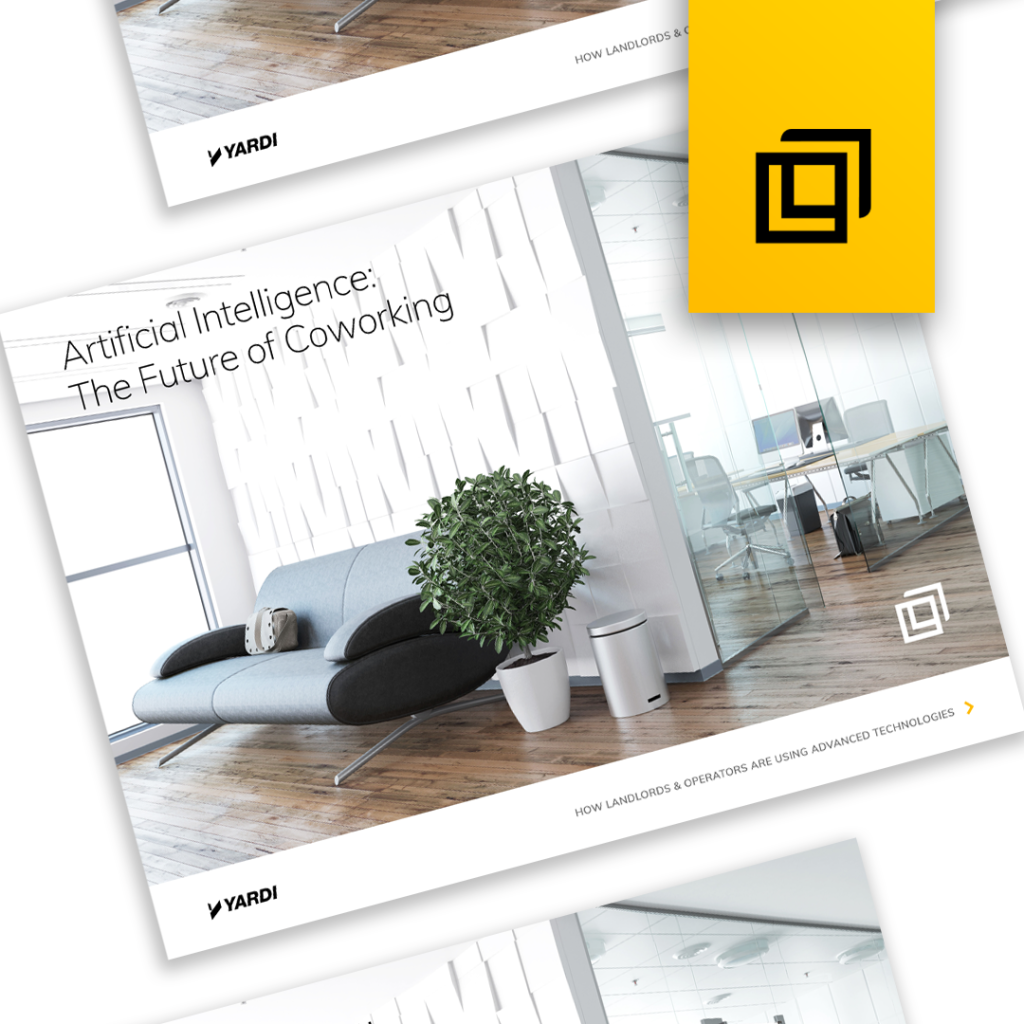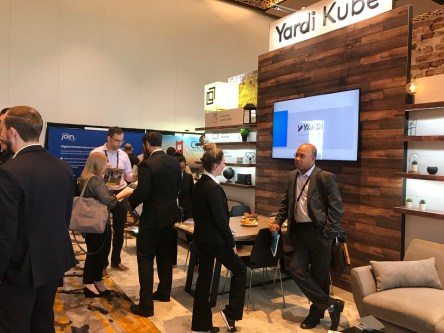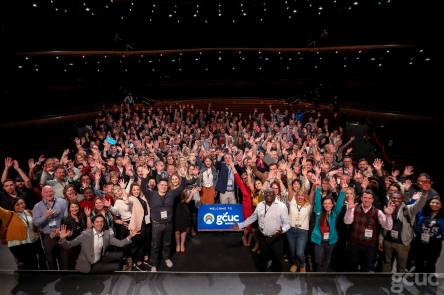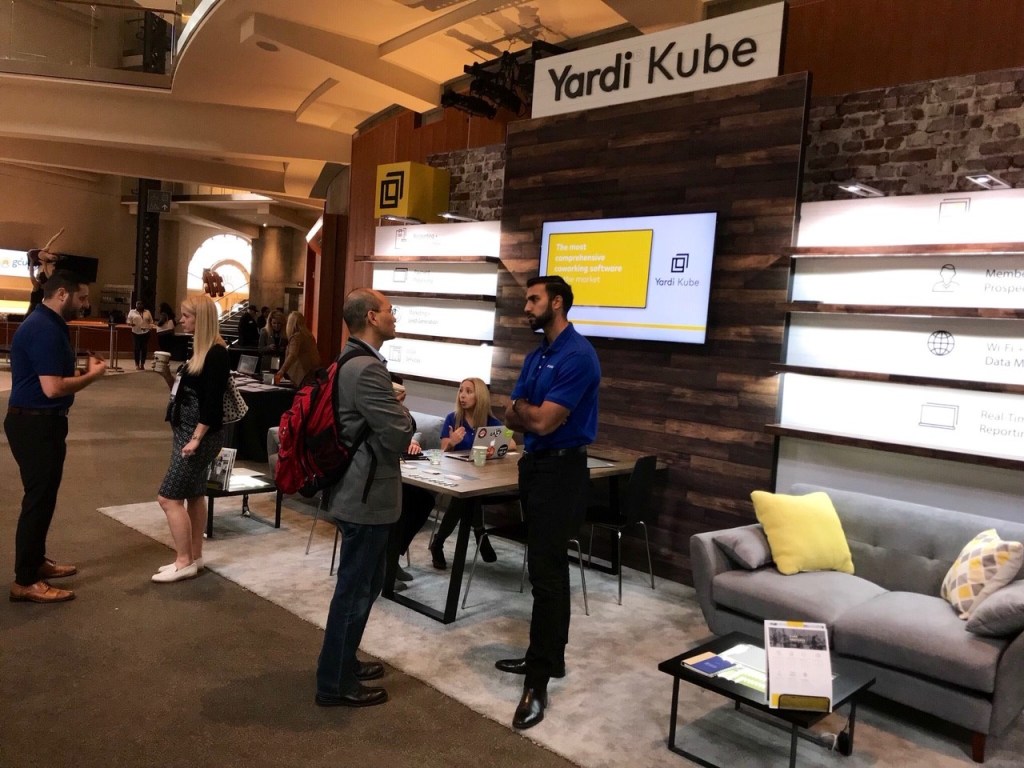Simply providing an open desk isn’t enough for coworking and flexible workspace providers in Canada. What else must space operators do to attract and retain tenants in this dynamic business? That was the topic of a recent panel discussion moderated by Warren Hersowitz, regional sales manager for Yardi Kube. The session at The Buildings Show in Toronto explored ways that space providers can serve members and improve staff efficiency at all stages of the business, from lead generation, IT infrastructure, and space and member management to accounting. Here is a recap of the key points discussed among panelists Christine Andrews, founder of Toronto coworking space provider Acme Works and a founder of Deco Group, a consultancy, and Kane Willmott, cofounder and CEO of iQ Offices, Canada’s largest independent coworking company. Maximize the member experience Creating value in a coworking space requires more than “just good coffee and Wi-Fi,” said Andrews. Settings that are attractive, enable flexible use of furniture and other items and provide opportunities for human connections help operators differentiate their offerings from competitors. “You, and your tenant, will get more out of the spaces when you include the human experience. Only focusing on the space misses an opportunity to charge more per square foot,” added Willmott. He described workspace leasing as shifting from a business-to-business model to business to consumer. Augment the experience with tech With shared space more prominent in the post-pandemic world, technology for managing shared space can make the difference. “Prospective tenants are less inclined to tour the space. That’s where a website that operators can use to post amenities as well as manage leasing and operations management makes a big difference,” Andrews said, adding, “Look for solutions that make it easier for your staff by speeding up the...
Coworking Trends
Explored at YASC Global
Yardi sought insight into a key office property management trend – flexible workspace arrangements – from a panel of clients at YASC Global. The three panelists, including Yael Urman, chief information officer for New York City-based commercial property developer Silverstein Properties, spelled out why the changing landscape requires greater flexibility. The days of the simple 15-year-lease-and-renew are over, Urman said, having been superseded by demands for work arrangement flexibility that can encompass everything from personalized work area coloring and furnishings to private offices. “We’re in the productivity, flexibility and well-being business now, not just providing four walls,” Urman said. “Our priority now is to offer any option that enables cooperation and enhances productivity for our clients.” Panelist Willie Gutierrez, COO/CFO of Premier Workspaces, an Irvine, Calif., coworking company that owns and leases flex office space, agreed that “it’s the experience, not the four walls” that matters for tenants in today’s office work environment. Gutierrez, whose company’s offerings include offices and conference rooms for as little as an hour, added that private offices for small and medium size businesses is Premier’s most popular offering. The third panelist, Brandon Van Orden, senior vice president and CIO for Atlanta office REIT Cousins Properties, senses a desire among workers to “get back in the office, collaborate in person and enjoy the social aspects of work. They still want big conference rooms for in-person meetings.” Accordingly, Van Orden and his Cousins colleagues describe their offerings as “flexible,” rather than “hybrid,” which implies that some workers remain permanently remote while others are permanently in the office. Cousins is also piloting technologies that create a seamless visitor experience that extends from the parking deck to the building entrance to the office, Van Orden said. Another key trend noted by the panelists...
Future of Coworking
AI & Internet of Things
One of the most significant trends in coworking and throughout the commercial real estate industry, is the advancement of uses for Artificial Intelligence (AI) and the Internet of Things (IoT). For managers and landlords, it leads to improvements in operational simplicity, features that increase revenue and reduce long-term costs with short-term investment. In our newest eBook, we analyze how AI and the IoT impact shared workspaces today and moving forward. We look at the most prevalent applications of advanced technologies in coworking then examine data on AI implementation and how it has evolved quickly over the past few years. Victor Vasev, Yardi senior director of coworking, explains how the Yardi Kube platform is using AI and IoT to help operators facilitate day-to-day business and adhere to social distancing guidelines for members. Finally, what is next for AI? Our eBook concludes with a look at the next steps for AI in the commercial and coworking sectors. Introduction to AI For the last decade, there has been consistent and rapid growth of coworking which has run parallel to the increase in the uses and potential for AI and IoT. Just about every aspect of our lives – comfort at home, entertainment, energy efficiency, transportation and now social distancing – have been altered by smart technology. The definitions of AI and IoT are intertwined, yet unique. The Internet of Things are internet-enabled devices, connected to collect and share data. Artificial Intelligence means your software gathers data, processes information and analyzes or makes predictions based off that data. In short, IoT is about connection and performing tasks, like requesting that Alexa turn down the temperature on your Nest thermostat. Artificial Intelligence goes beyond what human analysis is capable of to draw conclusions from data, like the Nest itself...
Home, Office
Multifamily + Coworking
Home is where the heart is, as well as the home office for some. All the time at home in front of a computer, however, can lead to feelings of isolation, a lack of inspiration, and a lack of meeting space for collaboration. Remote employees and freelancers turn to coworking spaces for help. To avoid a hectic commute, they seek coworking offices that are as close to home as possible. Herein lies renters’ problem that is an opportunity for multifamily and coworking owners. As the number of digital nomads grows, it outpaces coworking space availability especially in midsize and tertiary markets. Many multifamily communities aren’t equipped with the space, staff, or equipment needed to successfully operate their own coworking space on premises. This is where a collaboration between coworking organizations and multifamily properties can fill the void. Renters want coworking space but providers face challenges The 2020 National Multi-housing Council & Kingsley Apartment Resident Preferences Survey indicates that 46% of renters are interested in coworking space as a community amenity. Additionally, 48% are interested in conference or meeting rooms and 37% take interest in makerspace and DIY rooms. Unfortunately for renters outside of major metropolitan areas, coworking spaces are too far away, face limited availability, or are quite pricey. Some property managers will accommodate renters by creating a coworking space within the community. When space and staff are limited, that simply isn’t an option. For coworking firms outside of major metros, high rents may necessary to stay afloat with inconsistent membership revenues. A reliable base of clients would offer stability and an opportunity for growth but getting such leads is a struggle. Multifamily property and coworking leadership may be able to work together with mutual benefit. Considerations for coworking and multifamily property managers Space...
2019 GWA Recap
Yardi Kube a Sponsor
The 2019 GWA Conference, held this earlier this month in Washington, D.C., examined the latest trends in coworking. Yardi Kube was once again a platinum sponsor of this well-attended event, demonstrating a commitment to the coworking industry and showcasing new updates to the comprehensive coworking management platform. Let’s recap some of the highlights from conference breakout sessions. (Stay tuned for Part Two of this report, with additional insights.) Positioning your coworking space Led by Kevin Whelan, founder of Everspaces, this session was a discussion about customer purchases and what coworking operators can do to position themselves for quick success. Whelan explained that people, in general, buy on convenience or fidelity. Convenience is the purchase that’s based on how easily you can get something. Price, flexibility, and other ease of access factors play into these decisions. Fidelity is all about the experience. Customers will purchase things they truly love (think iPhones), irrespective of price. These purchases are based on status, visibility, elite design and service. Successful coworking operators must define themselves to attract members looking to purchase based on one of the two categories. For example, NeueHouse prides itself on providing a world class experience in Manhattan, NY and Hollywood, Calif. As a result, their pricing is considered among the highest in the industry. Nevertheless, NeueHouse is very successful. Regus, an industry leader, does not provide a ‘wow’ experience. But the company operates numerous coworking locations in major cities, so ease of access and flexibility when traveling is high. Regus price points are considered affordable. Both NeueHouse and Regus are profitable industry leaders in their own categories. Even niche spaces like The Wing, a women’s only coworking space, also operates a magazine, podcast, and retail store, among other ventures. But The Wing’s owners successfully use...
Coworking Marketing
Strategies and Ideas
As the coworking and shared space industry continues to grow and evolve, it’s becoming much more evident that profitability is not only viable, there are ways to maximize and continue to grow your profits as an operator. Let’s dive into the best coworking marketing strategy for maximum growth. Host Events You’ve likely heard about the potential for fantastic events at coworking spaces. One of the major keys to building your brand is to hold events that are open to the local community. It’s free advertising! People who would otherwise have never stepped foot in your space get firsthand access to all the benefits your space provides. Even if they are not coworking candidates, word of mouth is one of your biggest assets. The more people know about your location, have been inside and can speak to its benefits, the better for you of course. Here are some ideas for events that you could organize within your space: Community panel discussions ‘Breakfast and Learn’ / happy hours Singles’ meetup events Yoga classes Also, keep in mind, if your space does not have 24/7 access, a great way to increase revenue is to host private events after hours. Whether it’s birthday parties, receptions, sporting event watch parties, or just about anything else that you have the room for and would take place past typical working hours. Last year’s Global Coworking Survey revealed that 21% of operators found organizing events to be a top challenge for them, and 50% said attracting new members was a top challenge. These events, whether during or after hours, will solve for a large part of both of those obstacles. Want to learn more about coworking marketing strategies? Check out the rest of this post on the Yardi Kube...
Coworking Outlook
Changing the tech landscape
Editor’s note: this coworking perspective piece was authored by Justin Harley, regional director of coworking for Yardi, in association with Property Week. Harley was a co-founder of the flexible workspace management software Hubcreate. He joined the Yardi UK team in May. Having spent most of my career in the flexible workspace sector, I could not be more enthusiastic about how bright the future is for coworking and flexspace, and furthermore I am delighted to see technology and software leaders such as Yardi investing heavily in technology to fuel the growth and development of the sector. I have been privileged to see the coworking and flexspace sector grow from a few London-based serviced offices to what it is today, one of the fastest-growing parts of the real estate world. That said, it still only accounts for 4% of all deals in London, according to the latest research from Cushman & Wakefield and Colliers International. While real estate continues to develop an understanding of the coworking market, the industry is still a little shell-shocked about how it has crept up on them. That part of the real estate sector often misses the point when they debate coworking. I hear “we are not coworking, coworking doesn’t make money – when will the bubble burst?” Larger operators account for less than 13% of the market in the UK and the flexspace and coworking community is made up of businesses that care about innovation, member experience and the effect of their service on worker wellness. In short, it’s all about the customers and what makes them happy. Their obsession for customer service is what drives the industry. A happy client is a loyal client and, despite being on a flexible license, will stay for a long time. It is...
GCUC Recap
Coworking Conference Insights
Last month, Yardi Kube was introduced to the coworking world at the Global Coworking Unconference Conference (GCUC). The U.S. edition of the annual event was held in Denver from April 15-18. This popular coworking industry gathering provides attendees with extensive in-depth sessions with experts in the coworking space, educating them on financing, technology, community building, and branding. The first day of the event was a deep dive into especially hot topics for the coworking industry. Industry hot topics: making money Led by Jerome Chang of Blankspaces, the finance discussion focused on the number one way to make money as a coworking operator – through lease incentives. Fundraising methods for shared space startups include venture capital funding, personal loans, investment from friends and family members, and other avenues, but Chang shared that SBA loans for such businesses are unlikely. The average traditional office space will have about 165-185 square feet per employee. In a coworking space it could be as low as 50-70 square feet. Coworking operators can book common areas at up to 150 percent capacity, because your space won’t always be full (this uses the same logic as a gym membership: it’s possible to overbook because not everyone works out simultaneously). The biggest moneymaker, however, will be meeting rooms. They’re priced higher per hour than any other amenity or space in and should be rentable to the general public, as well as members. Virtual memberships provide a low-cost entry to members wanting to try out the industry. While individually, these memberships won’t be a primary source of income, it is a source of unlimited potential with no space restrictions. The Blankspaces model allocates 35-50 percent of space to private offices, Chang shared. And it’s important to make over 70 percent of your total available square footage...
Introducing Yardi Kube
Single Platform Coworking Solution
Yardi Kube™, a single platform solution for coworking and shared workspace operators, is now available. Introduced this week at the GCUC conference in Denver, Yardi Kube is designed to help coworking operators successfully grow their businesses, eliminate third party integrations, save time and offer competitive member services. With the powerful Yardi Voyager property management platform as its foundation, Yardi Kube combines accounts payable, general ledger, merchant services and more in one easy-to-use technology suite. Yardi Kube includes comprehensive accounting, online marketing integration and powerful reporting capabilities. Users will be able to easily report to owners and investors and market to new clients, all from within the platform. The member portal gives coworking members the ability to manage their profile, connect with other members, pay bills, purchase services and book space with one click. Yardi Kube can also handle management of Wi-Fi and VOIP systems. “We chose Yardi Kube because of its robust capabilities to manage our businesses. The fact that Yardi was behind the development gave us confidence in its reliability and development path,” said Willie Gutierrez, COO and CFO of Premier Workspaces, a nationwide shared workspace provider. “Yardi Kube is the long-awaited technology solution that will allow shared workspaces to scale and grow with ease,” said Dale Hersowitz, vice president of coworking at Yardi. “It maximizes efficiency, eliminates leakage and allows for real-time reporting, all in a single platform.” GCUC, which concludes tomorrow, is the world’s largest coworking event, with conferences held in five continents. About 300 attendees convened in Colorado for the event. At GCUC, the Yardi Kube team has been conducting demos of the new platform and sharing the product’s exciting features, including the accounting platform, internet listing service and prospect lifecycle tracking. “We look forward to showing the extent of Yardi’s commitment to coworking, what the future looks like for Yardi Kube, and how the platform separates itself from the competition,” said Dale Hersowitz, vice president of coworking at Yardi. GCUC attendees are invited to come by the Yardi Kube booth, #10-11, to see Yardi Kube in action. Visit yardikube.com to learn more about the benefits of an all-in-one coworking management solution for shared...
Australia Explores Coworking
Shared workspace practice expands
As coworking continues to gain traction in office markets around Australia, Neal Gemassmer, Yardi vice president of international, looks at the top three tech trends helping landlords stay ahead of the curve. This post is reprinted with permission and originally appeared in Property Australia. More coworking space in Australia was leased in 2018 than in the previous three years combined, finds recent research from JLL. Sydney and Melbourne accounted for nearly two-thirds (60%) of all coworking space – or 95,700 sqm – leased since 2015, JLL has found. But Australia’s other capitals are also jumping on board the coworking juggernaut. Meanwhile, Colliers has recorded a 46.9 per cent increase in flexible workspace in Sydney’s CBD last year. Although, with this representing just 2.44 per cent of the market, coworking is still in its early days. Gemassmer says Australia’s large office landlords are well placed to stay ahead of the curve if they embrace the right technology. He says three tech trends are at the heart of any successful coworking strategy. Know your customer with a CRM Every coworking space should have a customer relationship management system, or CRM in place, Gemassmer says. “A CRM will streamline lead entry, customer lifecycle tracking, vendor relationship management and a host of operational tasks – driving efficiency, enhancing productivity and ultimately leading to greater profitability.” Streamline systems with automated billing Whether you operate one space or multiple locations, automated billing is one of the most vital tech components to success, Gemassmer says. “Manual entry, regardless of how meticulously done, can create leakage – and this problem is worse when you’re a multi-space operator. “Operators who streamline their business with automated billing – particularly when done so alongside other tech-driven solutions – can offer the same product, but at a higher margin and lower cost.” There are software options which combine an accounting package with merchant services, such as the Yardi KUBE, which has a full general ledger suite and accounting package, Gemassmer explains. Let’s get connected “Not all coworking enablers are tech-driven,” Gemassmer observes. “Hosting after-hours events, creating sports teams or designing spaces to encourage incidental interaction are among the many ways to build a coworking community. “But ultimately, most coworking members spend their day sitting behind a screen, and this means tech plays a central role in building and enhancing that sense of community. “Yardi’s member portal helps members book meeting space, connect with an online marketplace, access special deals and pay invoices in just a few clicks. People may be attracted to coworking for its collaborative potential, but it will be the seamless technology experience that keeps them.” The new Yardi KUBE platform allows operators to seamlessly manage their coworking space operations and financials in a fully-integrated platform while providing a phenomenal member experience. Learn...
Key Features
For Coworking Software
As an operator of a coworking space, you’ll have many choices when selecting a management platform to power your shared workspace. Compare pros and cons and check what features each choice provide, but make sure these five features are included in your software. Robust Accounting Accounting is a vital component to the operation of your space. You may choose a software that integrates with third party applications such as Quickbooks, FreshBooks, or others. That is a significant step up from manual labor. In a perfect world however, your management platform would have all accounting solutions built in. This will eliminate third party apps for accounts payable, payment processing, merchant services, and reconciliation, among other functions. ILS There are numerous benefits to having an ILS (internet listing service) built into your coworking management software. List your space and eliminate marketing time and dollars. Potential members can check out your space at a glance, and improve the quality of your leads. In addition, you will greatly benefit from the ability to sell your services online in real time. Offer spaces, services, and just about anything else you can list. Keep track of sales and revenue live. Real-time Reporting Real-time reporting goes beyond just statistics. Being able to track data and results live will help you track sales, revenue, space usage, and many more driving factors of the success of your space. At the end of the day, the goal is to increase your revenue and provide better service to your members and guests. Real time reporting is at the core of all those goals, as you’ll have visibility to change membership plans, designs, and service based on tracking data over periods of time. Learn more about the benefits of CRM and automated booking in your coworking management software on the...
Yardi KUBE Preview
New, Single Platform Explained
Ed. Note: WUN KUBE has joined the family of Yardi property management software. KUBE provides a suite of technology products for coworking and shared space management. This piece on the new platform originally appeared on the KUBE Blog. As we approach the much anticipated release of the new Yardi KUBE platform, we conducted a client-exclusive Q&A session to address a variety of topics. The response was overwhelmingly positive and we cannot wait to debut the new KUBE. We will beta launch in January 2019, and full roll-out is set for April. Below, we’re going to summarize some of the main talking points from the recent webinar. What are the main changes for KUBE? It’s tough to put into words exactly the incredible extent to which Yardi is impacting our platform, but we tried to do so again in the webinar. Dale Hersowitz, our VP of Coworking, explained that Yardi is best known for building software for the real estate industry, from commercial to multiunit to many other facets. They are now fully diving into the Coworking world with the acquisition of WUN last year. The most important change for KUBE is essentially putting together a single stack. What does that mean? Yardi has a full general ledger suite, an accounting package, they’re also a merchant, they offer a vendor procurement solution, they are an e-broker, and KUBE will continue to provide the operational component to power your day to day functions of your space. No more third-party integrations. Yardi will encompass 7 modules in one tightly integrated solution. Everything in a single platform allows for greater efficiency, cost savings, prevents leakage, and enables operators to scale effectively. Enhancements and New Features The attendees asked several questions regarding the enhancements of the new platform. Yardi has a...
Coworking Security
7 Ways to Keep Everyone Safe
As the manager of a coworking space, you walk a fine line. Your site must offer security while helping members and guests feel welcome. The following seven tips promote digital and physical security without interrupting ease-of-use. Create a Warm, Automated Welcome Automated attendance trackers deliver convenient yet controlled access to your shared workspace. Combine Kisi and KUBE door access systems to manage member and visitor logs as well as billing details. There is no need to have users register and pay for common use areas in advance. Users pay as they go, minimizing cancellations and billing disputes. As an added convenience, any user with a mobile device can begin working automatically. With access and billing aside, your reception staff can focus on welcoming clients, answering questions, and placemaking. Offer Private Wi-Fi As an alternative to shared wi-fi networks, private networks provide excellent digital security. Each user receives a unique code that doesn’t overlap with fellow users’ access. Consider linking access with membership. A single code issued to all members and guests does not provide the protection you need. Link access codes to users’ unique membership level as an additional layer of security. Have that code expire with the membership or expire after a certain duration of time for guests. Switch Up Guest Access If individualized wi-fi credentials for guests seems tedious, consider a simple guest wi-fi network and password. For added security, update log-ins at least every quarter, if not every month. Encourage Privacy with Filters Install an IP filtering system that can minimize undesirable data sharing and burdensome traffic loads. Not all data theft occurs digitally. Applying privacy screen filters on your in-house computer monitors limits the access of wandering eyes. Benefit from Member Education Education is key to risk mitigation. During new...













